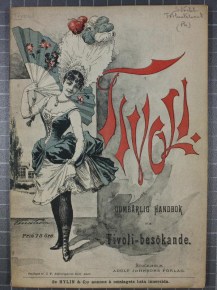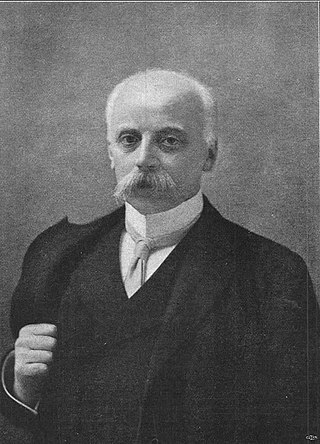| |||||
| Decades: | |||||
|---|---|---|---|---|---|
| See also: | |||||
Events from the year 1905 in Sweden
| |||||
| Decades: | |||||
|---|---|---|---|---|---|
| See also: | |||||
Events from the year 1905 in Sweden


Gustaf V was King of Sweden from 8 December 1907 until his death in 1950. He was the eldest son of King Oscar II of Sweden and Sophia of Nassau, a half-sister of Adolphe, Grand Duke of Luxembourg. Reigning from the death of his father Oscar II in 1907 to his own death nearly 43 years later, he holds the record of being the oldest monarch of Sweden with the third-longest reign after Magnus IV (1319–1364) and Carl XVI Gustaf (1973–present). He was also the last Swedish monarch to exercise his royal prerogatives, which largely died with him, although they were formally abolished only with the remaking of the Swedish constitution in 1974. He was the first Swedish king since the High Middle Ages not to have a coronation and so never wore the king's crown, a practice that has continued ever since.

Nils Edén was a Swedish historian and liberal politician who served as Prime Minister of Sweden from 1917 to 1920, and along with Hjalmar Branting acknowledged as co-architect of Sweden's transition from a constitutional monarchy to a fully parliamentary democracy with equal male and female suffrage.

Erik Gustaf Bernhard Boström was a Swedish landowner and politician who was a member of the Swedish Parliament (1876–1907) and the longest-serving Prime Minister of Sweden of the 19th century. He served twice, first from 1891 to 1900 and then again from 1902 to 1905. He was also known as E.G. Boström or E. Gust. Boström.

Per Alfred Petersson was a Swedish politician and minister for agriculture in several cabinets.

The dissolution of the union between the kingdoms of Norway and Sweden under the House of Bernadotte, was set in motion by a resolution of the Storting on 7 June 1905. Following some months of tension and fear of an outbreak of war between the neighbouring kingdoms – and a Norwegian plebiscite held on 13 August which overwhelmingly backed dissolution – negotiations between the two governments led to Sweden's recognition of Norway as an independent constitutional monarchy on 26 October 1905. On that date, King Oscar II renounced his claim to the Norwegian throne, effectively dissolving the United Kingdoms of Sweden and Norway, and this event was swiftly followed, on 18 November, by the accession to the Norwegian throne of Prince Carl of Denmark, taking the name of Haakon VII.

Karl Albert Staaff was a Swedish liberal politician and lawyer who served as the Prime Minister of Sweden from 1905 to 1906 and again from 1911 to 1914. He was chairman of the Liberal Coalition Party from 1907 to 1915. He was Sweden's first liberal prime minister, as well as its last prime minister whose governance was ended by a lack of monarchical support.

Knut Hjalmar Leonard Hammarskjöld was a Swedish politician and scholar who was Prime Minister of Sweden from 1914 to 1917. He was a member of the Riksdag from 1923 to 1938 in the first chamber. He headed Sweden's government during most of World War I, and maintained the nation's neutrality in that conflict. He was ideologically conservative, although he was never officially a member of any political party.

Johan Olof Ramstedt was Prime Minister of Sweden from April to August 1905.

Christian Lundeberg was a Swedish politician who served as Prime Minister of Sweden from 2 August to 7 November 1905.

The Union between Sweden and Norway is an overriding theme of the history of Sweden in the 19th century. On 4 November 1814, the kingdoms of Sweden and Norway formed a personal union under one king. The two countries had completely separate institutions, except for the foreign service led by the king through the Swedish foreign minister.

Johan Fridtjuv Berg was a Swedish school teacher, author, and politician (liberal); he was minister of education and ecclesiastical affairs from 1905 to 1906 and 1911 to 1914 and Member of Parliament from 1891 to 1916. Berg was the son of educator Anders Berg and father of historian Tor Berg and artist Yngve Berg.

Events from the year 1891 in Sweden

Events from the year 1900 in Sweden

Events from the year 1898 in Sweden

Events from the year 1899 in Sweden

Events from the year 1912 in Sweden.
Events from the year 1913 in Sweden

August Gyldenstolpe is a Swedish politician and diplomat who from 22 December 1904 until 2 August 1905 served as Minister of Foreign Affairs of Sweden.
Mot nya tider is a Swedish film from 1939 directed by Sigurd Wallén. It portrays the dissolution of the union between Norway and Sweden. The film was shot from February to May 1939 at Sandrew Studios in Stockholm and in Karlstad, Oslo, and Trondheim.